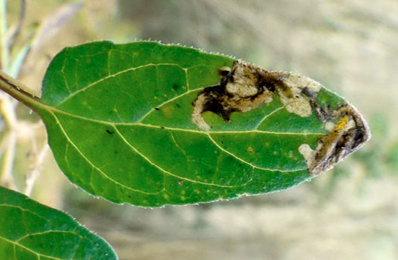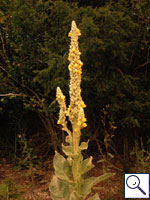|
||||||
|
VERBASCUM. Mulleins. [Scrophulariaceae] |
|
|
Eighteen species of Verbascum are recorded in Britain. These include the native White Mullein (V. lychnitis), Dark Mullein (V. nigrum), Hoary Mullein (V. pulverulentum), Great Mullein (V. thapsus) and Twiggy Mullein (V. virgatum) and the introduced Cretan Mullein (V. creticum). Five British miners are recorded on Verbascum. The agromyzid Napomyza scrophulariae is recorded feeding in both seed heads and stems of Digitalis pupurea and possibly Scrophularia nodosa, Verbascum and Mentha in Britain. A key to the European miners recorded on Verbascum is provided in Bladmineerders van Europa. |
|
Key for the identification of the known mines of British |
1a > Leaf-miner: A distinctive mine primarily above mid-rib, with irregular short lateral offshoots into leaf blade. Pupation external (Spencer, 1972: 51 (fig. 172), 55; Spencer, 1976: 270, 271 (fig. 486)). Branched, whitish, upper-surface corridor; main axis overlying the midrib; side branches overlying the main lateral veins. (In Campanula and Phyteuma the mine is much less branched, sometimes nothing more than a corridor on top of the midrib). Frass in rather long strings. Usually the mines begins as a long and narrow, shallow, tortuous lower-surface corridor that ends upon the midrib but otherwise is not associated with the leaf venation. Often this initial corridor is filled with callus, and then even less conspicuous. Pupation outside the mine. A linear mine on the upper surface, usually following the midrib and showing side branches along the veins. The frass is in strings. |
|
Liriomyza strigata (Meigen, 1830) [Diptera: Agromyzidae]. |
1b > Leaf-miner: A linear-blotch mine, often with several mines occurring in the same leaf (Spencer, 1976: 167, fig. 305). A short, mostly upper-surface, rarely partly lower-surface corridor leads to a large, upper-surface, primary blotch. The mine initially is pale, turns brown later. Frass in sizeable dispersed grains. Pupation outside the mine; the larva leaves the mine through a semicircular exit slit in the upper epidermis. Upper surface variable mine, from a short gallery leading to a large, roundish blotch to a long gallery leading to an elongated blotch. |
|
Amauromyza verbasci (Bouché, 1847) [Diptera: Agromyzidae]. |
1c > Leaf-miner: A short, irregular, linear upper surface mine on any part of the leaf. Also recorded from young pods (Bland, 1997a). Long corridor mine. As a rule the first part of the mine is lower-surface, the later part upper-surface. Often the loops are so dense that a secondary blotch is the result. Because upper- and lower-surface corridor segments often cross, the mine obtains a strange array of transparant patches. There is no association with the midrib. Frass in strings and thread fragments. Pupation outside the mine; exit slit in upper epidermis. Mine not associated with the veins or midrib of the leaf (It is this character which enables distinction from another Agromyzid pest species - Liriomyza huidobriensis). The larvae may leave one leaf (if not large enough) and enter another leaf, via the petiole). It exits the leaf to pupate through a semi-circular slit in the upper surface of the leaf. |
|
Liriomyza bryoniae (Kaltenbach, 1858) [Diptera: Agromyzidae]. |
1d > Leaf-miner: Rather long full depth corridor that winds freely through the leaf and may cross itself. In the end the corridor widens considerably. Frass mostly in a narrow central line, but may also be deposited along the sides or be missing. The larvae regular leave a mine to restart elsewhere. Pupation outside the mine. Neither larva or mine can be distinguished from that of related species. |
|
Apteropeda orbiculata (Marsham, 1802) [Coleoptera: Chrysomelidae]. |
1e > Leaf-miner: Rather narrow corridor, untidy and sometimes branched, starting from the base of the leaf, in particular the midrib. Sides of the corridor irregularly eaten out, not really parallel. Frass mostly present, and then in a central line. The larva is capable of leaving the mine and start a new one elsewhere. These later mines are much broader, and the frass is scattered irregularly.. |
 Mine of Orthochaetes insignis on Prunella vulgaris Image: © Jean-Yves Baugnée (Bladmineerders van Europa) |
|
Orthochaetes insignis (Aube, 1863) [Coleoptera: Curculionidae]. |
| Last updated 13-Feb-2018 Brian Pitkin | ||

